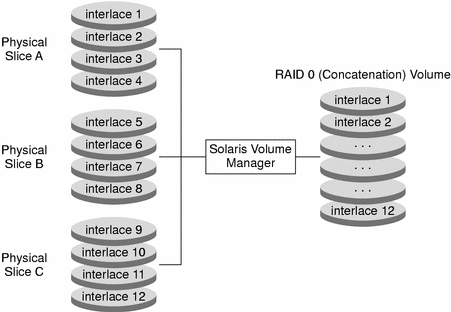RAID 0 (Concatenation) Volume
A concatenated volume, or concatenation, is a volume whose data is organized serially and adjacently across components, forming one logical storage unit.
Use a concatenation to get more storage capacity by combining the capacities of several components. You can add more components to the concatenation as the demand for storage grows.
A concatenation enables you to dynamically expand storage capacity and file system sizes online. With a concatenation you can add components even if the other components are currently active.
Note –
To increase the capacity of a stripe, you need to build a concatenated stripe. See RAID 0 (Concatenated Stripe) Volume.
A concatenation can also expand any active and mounted UFS file system without having to bring down the system. In general, the total capacity of a concatenation is equal to the total size of all the components in the concatenation. If a concatenation contains a slice with a state database replica, the total capacity of the concatenation would be the sum of the components minus the space that is reserved for the replica.
You can also create a concatenation from a single component. Later, when you need more storage, you can add more components to the concatenation.
Note –
You must use a concatenation to encapsulate root (/), swap, /usr, /opt, or /var when mirroring these file systems.
Scenario—RAID 0 (Concatenation)
Figure 7–2 illustrates a concatenation that is made of three components (slices).
The data blocks, or chunks, are written sequentially across the components, beginning with Disk A. Disk A can be envisioned as containing logical chunks 1 through 4. Logical chunk 5 would be written to Disk B, which would contain logical chunks 5 through 8. Logical chunk 9 would be written to Drive C, which would contain chunks 9 through 12. The total capacity of volume d1 would be the combined capacities of the three drives. If each drive were 2 Gbytes, volume d1 would have an overall capacity of 6 Gbytes.
Figure 7–2 Concatenation Example

- © 2010, Oracle Corporation and/or its affiliates
